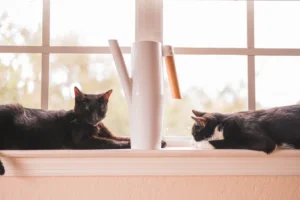Cats have a reputation for being aloof and independent pets, but why are they randomly mean? Understanding the reasons behind their occasional aggressive behavior can help cat owners navigate their feline companions’ moods more effectively.
Feline Instincts
Have you ever wondered why your cat sometimes acts out of character and displays aggression seemingly out of nowhere? Well, it all boils down to their feline instincts. Cats are natural hunters, and they have a strong territorial drive. When they feel threatened or stressed, they may lash out in an attempt to protect themselves or their territory.
This instinctual behavior can often manifest as aggression towards humans, especially if they feel cornered or perceive you as a threat. It’s essential to understand that your cat isn’t being mean just for the sake of it; they are simply reacting based on their instincts.
To help mitigate this behavior, it’s crucial to provide enrichment for your cat, such as interactive toys and scratching posts, to satisfy their natural hunting instincts. Additionally, creating safe spaces in your home where your cat can retreat and feel secure can help reduce their stress levels and minimize aggressive outbursts.
Socialization Factors
Early socialization plays a significant role in shaping a cat’s behavior towards humans. Kittens that are properly socialized from a young age are more likely to form positive relationships with people and exhibit less aggression as they grow older. On the flip side, cats that lack early socialization may be more prone to displaying aggressive behavior.
If you have adopted a rescue cat or a kitten that hasn’t been properly socialized, don’t worry – it’s never too late to work on building a strong bond with your feline friend. Consistent positive interactions, patience, and understanding can go a long way in helping your cat feel more comfortable and less inclined to act aggressively.
In addition to socialization, providing regular mental and physical stimulation for your cat is crucial in preventing behavioral issues. Play sessions, puzzle toys, and rotating their environment can help keep your cat engaged and content. Remember, a well-stimulated cat is a happy cat!
Stress Triggers
Cats can be randomly mean due to various stress triggers in their environment. Changes like moving to a new place, bringing in a new pet, or even rearranging furniture can throw off their sense of security. Cats are creatures of habit and disruptions can make them irritable.
One unique insight to consider is that cats are sensitive to changes in routine. They thrive on predictability, so any disruptions can lead to stress. Even small changes, like feeding them at different times or using a new brand of litter, can upset them. By understanding your cat’s routine and minimizing changes, you can help reduce their stress levels.
Body Language Cues
Understanding your cat’s body language is crucial in preventing aggressive behavior. Cats communicate through their body posture, vocalizations, and facial expressions. Learning to interpret these cues can help you anticipate when your cat is feeling threatened or overwhelmed.
Common body language cues to watch for include:
– Arched back: Indicates fear or aggression.
– Flattened ears: Sign of irritation or anger.
– Tail flicking: Shows agitation or annoyance.
– Hissing or growling: Indicates aggression or defensiveness.
By paying attention to these signals, you can intervene before your cat escalates to aggressive behavior. Taking the time to learn your cat’s unique body language cues can help you build a stronger bond and prevent misunderstandings.
Positive Reinforcement
Has your furry feline been acting out lately, showing some claws where they shouldn’t be? Don’t worry, you can turn this behavior around with some positive reinforcement techniques. Cats respond well to rewards for good behavior, so try using treats, toys, or extra attention when they’re being pleasant. By praising and rewarding them when they’re calm and friendly, you can encourage more positive interactions and reduce those random mean streaks.
Additionally, try to redirect their energy towards more appropriate outlets. Provide scratching posts, interactive toys, or play sessions to help them release any pent-up frustration or aggression in a healthy way. Remember, consistency is key – be patient and keep reinforcing positive behavior to see lasting changes in your cat’s demeanor.
Medical Issues
Is your usually cuddly cat suddenly lashing out for no apparent reason? It might be time to consider if there are underlying medical issues causing this behavior. Cats can become aggressive when they’re in pain or discomfort, so it’s essential to rule out any health problems with a visit to the vet.
Some common medical issues that can contribute to aggression in cats include dental problems, arthritis, urinary tract infections, or even neurological issues. Your vet can perform a thorough examination to identify any potential health issues and recommend appropriate treatment. Remember, addressing the root cause of your cat’s aggression is crucial for their well-being and can lead to a happier, more peaceful relationship between you and your feline friend.
Signs of Possible Medical Issues:
- Excessive grooming or lack of grooming
- Changes in appetite or water intake
- Lethargy or decreased activity levels
- Vocalizing more than usual
- Weight loss or gain
- Changes in litter box habits
Don’t ignore any sudden changes in your cat’s behavior – they could be trying to tell you that something isn’t right. Consulting with your vet is always the best course of action to ensure your cat’s health and happiness.
Play Therapy
Is your cat’s behavior leaving you scratching your head? One reason cats might act mean is because they have excess energy or aggression pent up inside them. Engaging in interactive play sessions can help redirect this aggressive energy in a positive way. Use toys like feathers on a stick or laser pointers to get your feline friend moving and pouncing. Not only does play therapy provide an outlet for their aggression, but it also gives them mental stimulation and can strengthen your bond. Remember, a tired cat is a happy cat!
Creating a Safe Environment
Wondering why your cat is lashing out unpredictably? Sometimes, cats act mean because they feel threatened or anxious in their environment. To help alleviate their mean behavior, ensure your home is a safe and enriching space for them. Provide hiding spots, vertical spaces, scratching posts, and comfy beds to help your cat feel secure. Additionally, consider creating a routine for feeding and playtime to give your cat a sense of stability. By creating a safe and stimulating environment, you can help calm your cat’s nerves and reduce their mean tendencies.
Tips for a Safe Environment:
- Scratch That Itch: Make sure to provide appropriate scratching surfaces like scratching posts to prevent your cat from taking out their frustrations on your furniture.
- Climb High: Cats love to climb and observe their surroundings from above. Invest in cat trees or shelves to give them vertical spaces to explore.
- Quiet Oasis: Cats are sensitive to noise and commotion. Create quiet spaces where your feline friend can retreat to for some peace and quiet.
- Interactive Toys: Keep your cat mentally stimulated with interactive toys that challenge their hunting instincts. Consider puzzle feeders or treat-dispensing toys to keep them engaged.
- Regular Vet Visits: Some mean behavior in cats can be due to underlying health issues. Regular visits to the vet can help rule out any medical reasons for their aggressive tendencies.
Fun Cat Facts
Uncover some fascinating facts about feline behavior and characteristics that may shed light on why cats can be randomly mean.
Cats have a strong sense of independence, which can lead to occasional aloof or aggressive behavior. This independence stems from their ancestors who were solitary hunters, allowing them to survive in the wild. So, when your cat acts mean, it may be their way of asserting their autonomy.
Research has shown that cats can experience stress and anxiety, just like humans. Changes in their environment, such as a move to a new home or the introduction of a new pet, can trigger aggressive behaviors. Understanding your cat’s triggers and creating a calm, predictable environment can help reduce mean behaviors.
Cats communicate through body language, vocalizations, and behavior. When a cat feels threatened or uncomfortable, they may exhibit aggressive behaviors as a way to protect themselves. Learning to interpret your cat’s signals can help prevent misunderstandings and reduce instances of meanness.
Fun Fact: Cats have a unique grooming behavior called ‘allogrooming,’ where they groom each other as a sign of affection and social bonding. Encouraging positive interactions like grooming sessions can strengthen your bond with your cat and reduce mean behaviors.
By understanding these fun facts about feline behavior, you can better navigate your cat’s moods and create a more harmonious relationship with your furry friend.
Tips for Dealing with Mean Behavior
- Provide Enrichment: Keep your cat mentally stimulated with toys, puzzles, and interactive play to prevent boredom and frustration.
- Playtime: Regular play sessions can help release pent-up energy and reduce stress, leading to fewer mean outbursts.
- Positive Reinforcement: Reward good behavior with treats or praise to encourage positive interactions and discourage meanness.
- Consult a Vet: If your cat’s mean behavior is sudden or extreme, it’s essential to rule out any underlying medical issues by consulting a veterinarian.
- Respect Boundaries: Cats have personal space boundaries; respect their need for alone time and avoid forcing interactions when they’re not in the mood.
Remember, patience and understanding are key when dealing with a mean cat. With the right approach and care, you can help your feline companion feel more secure and content.
Alex, a passionate animal lover, has experience in training and understanding animal behavior. As a proud pet parent to two dogs and three cats, he founded AnimalReport.net to share insights from animal experts and expand his knowledge of the animal kingdom.









